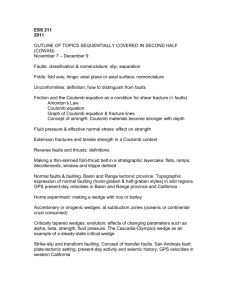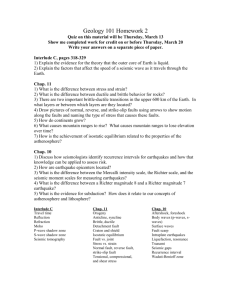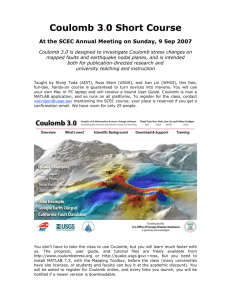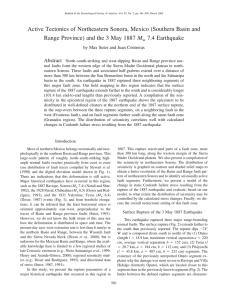Model - Supersites
advertisement
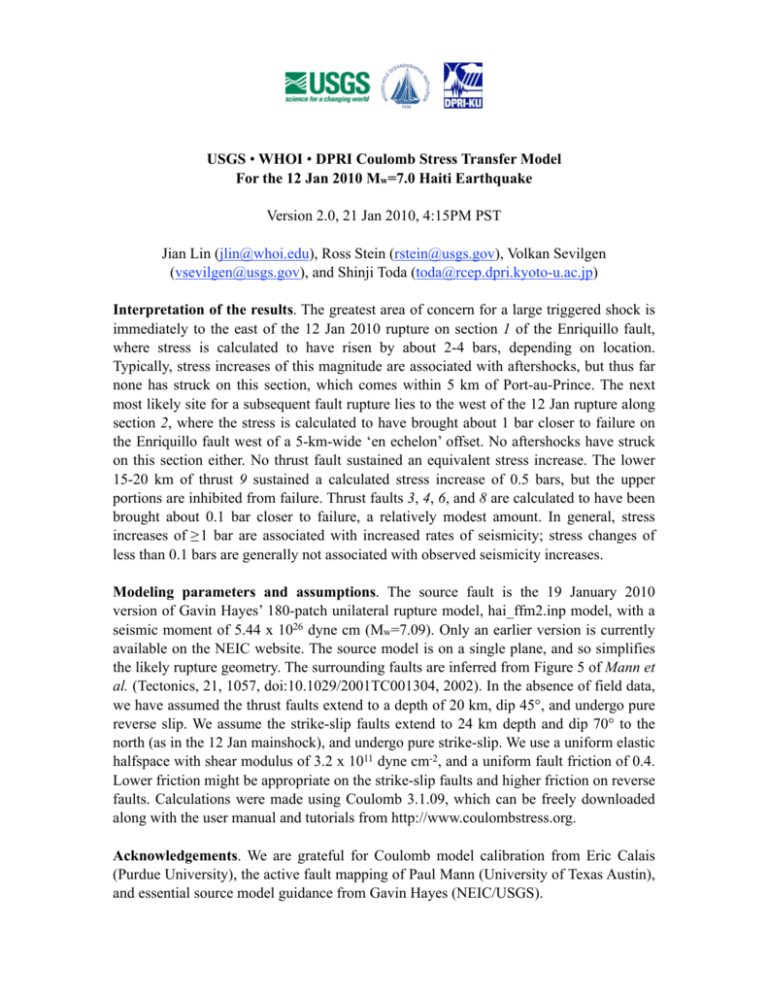
USGS • WHOI • DPRI Coulomb Stress Transfer Model For the 12 Jan 2010 Mw=7.0 Haiti Earthquake Version 2.0, 21 Jan 2010, 4:15PM PST Jian Lin (jlin@whoi.edu), Ross Stein (rstein@usgs.gov), Volkan Sevilgen (vsevilgen@usgs.gov), and Shinji Toda (toda@rcep.dpri.kyoto-u.ac.jp) Interpretation of the results. The greatest area of concern for a large triggered shock is immediately to the east of the 12 Jan 2010 rupture on section 1 of the Enriquillo fault, where stress is calculated to have risen by about 2-4 bars, depending on location. Typically, stress increases of this magnitude are associated with aftershocks, but thus far none has struck on this section, which comes within 5 km of Port-au-Prince. The next most likely site for a subsequent fault rupture lies to the west of the 12 Jan rupture along section 2, where the stress is calculated to have brought about 1 bar closer to failure on the Enriquillo fault west of a 5-km-wide ‘en echelon’ offset. No aftershocks have struck on this section either. No thrust fault sustained an equivalent stress increase. The lower 15-20 km of thrust 9 sustained a calculated stress increase of 0.5 bars, but the upper portions are inhibited from failure. Thrust faults 3, 4, 6, and 8 are calculated to have been brought about 0.1 bar closer to failure, a relatively modest amount. In general, stress increases of ≥1 bar are associated with increased rates of seismicity; stress changes of less than 0.1 bars are generally not associated with observed seismicity increases. Modeling parameters and assumptions. The source fault is the 19 January 2010 version of Gavin Hayes’ 180-patch unilateral rupture model, hai_ffm2.inp model, with a seismic moment of 5.44 x 1026 dyne cm (Mw=7.09). Only an earlier version is currently available on the NEIC website. The source model is on a single plane, and so simplifies the likely rupture geometry. The surrounding faults are inferred from Figure 5 of Mann et al. (Tectonics, 21, 1057, doi:10.1029/2001TC001304, 2002). In the absence of field data, we have assumed the thrust faults extend to a depth of 20 km, dip 45°, and undergo pure reverse slip. We assume the strike-slip faults extend to 24 km depth and dip 70° to the north (as in the 12 Jan mainshock), and undergo pure strike-slip. We use a uniform elastic halfspace with shear modulus of 3.2 x 1011 dyne cm-2, and a uniform fault friction of 0.4. Lower friction might be appropriate on the strike-slip faults and higher friction on reverse faults. Calculations were made using Coulomb 3.1.09, which can be freely downloaded along with the user manual and tutorials from http://www.coulombstress.org. Acknowledgements. We are grateful for Coulomb model calibration from Eric Calais (Purdue University), the active fault mapping of Paul Mann (University of Texas Austin), and essential source model guidance from Gavin Hayes (NEIC/USGS). 19.4° Haiti Legend 6 Un-named faults 5 Population density (Landscan 2004) D.R. NEIC epicenter 19.0° Gon ave 18.6° a 10 2 E n r iq u i l l o 18.2° 7 xtent ftershock e ture 12 Jan rup 1 4 fa u lt Port-au-Prince 9 6 8 40 km 17.8° 3 USGS • WHOI • DPRI Coulomb Stress Model For the 12 Jan 2010 Mw = 7.0 Haiti Earthquake Version 2.0, 21 Jan 2010, 4:15PM PST −73.4° −0.5 −73.0° −72.6° −72.2° −71.8° 0.0 Reduced 0.5 Coulomb stress changes (bars) on individual ‘receiver’ faults friction coeff. = 0.4 Hazard Increased Jian Lin (jlin@whoi.edu), Ross Stein (rstein@usgs.gov), Volkan Sevilgen (vsevilgen@usgs.gov), and Shinji Toda (toda@rcep.dpri.kyoto-u.ac.jp)



